Netflix’s Orange Is The New Black debuted at a perfect time for numerous reasons — like that we were starving, really, for a racially diverse female-driven show unafraid to tackle queer and transgender narratives. But the timing is particularly perfect politically, because now more than ever the shameful, counterproductive, racially biased and monumentally expensive criminal justice system deserves national interrogation, and this show could potentially help move that conversation forward. Presently, the U.S. is home to 5% of the world’s population and 25% of the world’s prison inmates and women are this country’s fastest-growing prison population.
It’s historically been difficult to generate activist attention around criminal justice reform, but increasing media attention could add more hearts/minds/bodies to the thousands who’ve been battling these issues tirelessly for years, like The Sentencing Project, The Women’s Prison Association, Families Against Mandatory Minimums and The ACLU. The issues many prison reformers are passionate about have gained new traction thanks to Michelle Alexander’s The New Jim Crow: Mass Incarceration in the Age of Colorblindness, released in January; Chasing Gideon: The Elusive Quest for Poor People’s Justice, released in March; the 2013 HBO Documentary Gideon’s Army and the October 2012 documentary The House I Live In.
And now we have Orange is The New Black, the first American television program since Oz to so poignantly dramatize, eroticize and criticize the system. Plus, OITNB does a thing Oz rarely did, which is make us laugh. As formerly incarcerated writer Joe Loya wrote about why he prefers OITNB to Oz: “The show — though not a biopic, therefore not literally accurate — still captures truthfully the zaniness of prison. And the sex agonies. The fortunate camaraderie. The hidden likenesses between the guards and prisoners. The collaborations. The antagonisms. The pain of family visits.” Also: The humanity. You cannot write these people off.
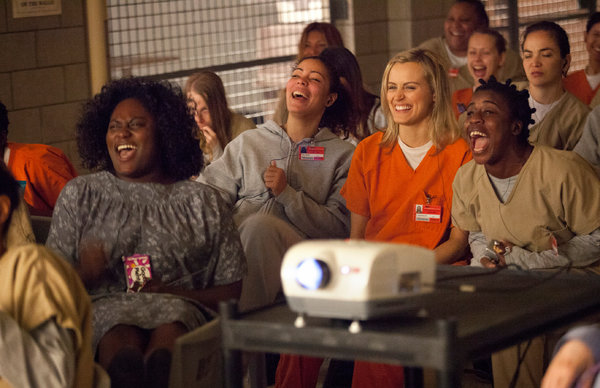
In this article I will look at how the stories from the movie compare to the memoir, and what both can teach us about women in America’s federal prisons. If you plan on reading the memoir, don’t read this article, because it’s chock-full of spoilers! For the purposes of this article, I’m gonna refer to Piper Kerman, the author of the book, as Kerman, and Piper Chapman, the protagonist of Orange is the New Black, as Chapman. Just like they do in prison! When I’m referring to events that happen to both humans — the real and the character — I’ll use “Piper.”

Disclaimer: I’m not gonna be digging into institutional mental health care (which I have a lot of personal feelings about!) or issues relating to prison staff and sexual abuse because those topics are too enormous for this post. I’m also not gonna discuss the treatment of transgender women in prison, because Mey already did. So, onward!
The Basics: Women In Prison
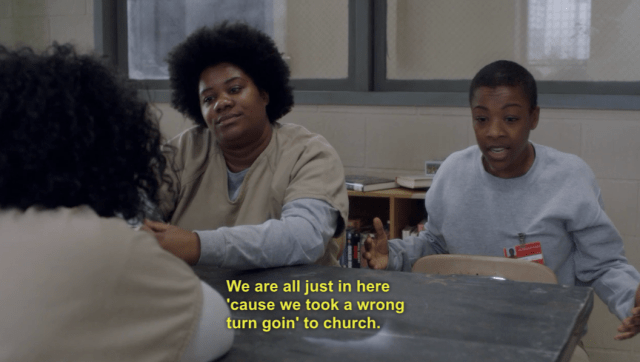
Most of the women in the Camp were poor, poorly educated, and came from neighborhoods where the mainstream economy was barely present and the narcotics trade provided the most opportunities for employment. Their typical offenses were for things like low-level dealing, allowing their apartments to be used for drug activity, serving as couriers, and passing messages, all for low wages. Small involvement in the drug trade could land you in prison for many years, especially if you had a lousy court-appointed lawyer. Even if you had a great Legal Aid lawyer, he or she was guaranteed to have a staggering caseload and limited resources for your defense. It was hard for me to believe that the nature of our crimes was what accounted for my fifteen-month sentence versus some of my neighbors much lengthier ones. I had my fantastic private attorney and a country-club suit to go with my blond bob.
– Piper Kerman, Orange Is The New Black
According to The Sentencing Project, the number of women incarcerated increased by 646% between 1980 and 2010, from 15,118 to 112,797. (The number of men in prison has increased 419% in that time.) Accounting for local jails raises that number to 205,000, and adding women on probation or parole gets you over a million women currently under the supervision of the criminal justice system. As of 2010, black women have been incarcerated at nearly three times the rate of white women, and Hispanic women were incarcerated at 1.6 times the rate of white women. In recent years, the rates of black women incarcerated has been going down while rates of incarceration for Hispanic and Latina women have been increasing. As Dorothy E. Roberts writes in The UCLA Law Review, “Mass imprisonment of blacks and Latinos allows the state to exert direct control over poorly educated, unskilled, and jobless people who have no place in the market economy because of racism. It also preserves a racial caste system that civil rights reforms were supposed to abolish.”
Furthermore, somewhere between 48 and 88 percent of women in prison are survivors of physical and sexual abuse prior to entering prison, where they’re at risk for further abuse from guards. 10% of female inmates report sexual abuse while incarcerated. According to The Michigan Women’s Justice & Clemency Project, as many as 90% in women in prison for killing a man were battered by those men, and whereas men are sentenced 2-6 years on average for killing their intimate partners, women are sentenced on average 15 years for killing their partners.
Roberts writes: “For most of these women, prison constitutes a culminating victimization that results from multiple forms of vulnerability and violation, including domestic violence, sexual abuse, drug addiction and other health problems, and homelessness… black women who lack adequate access to drug treatment are most vulnerable to the punitive approach.”
Most arrested for drug violations will plead guilty regardless of actual guilt to avoid going to trial and getting one of those 5-10 year mandatory minimum sentences currently jacking up prison populations. There’s minimal legal aid for poor inmates, too, which is one of many reasons that guilty plea bargains concluded 97% of all federal cases in 2011, and that so many innocent poor women and women of color are locked up. Two-thirds of female inmates are non-violent offenders like Piper, who pleaded guilty in exchange for a reduced 15-month sentence. As Poussey points out to Taystee, there are plenty of women in “Litchfield” who committed no crime at all, just “doing 15 years for lettin’ their boyfriends do deals in the kitchen ’cause they was afraid of getting beat if they said no.”
Prisons are overcrowded and budgets are ballooning. A few weeks ago, the Department of Justice sent a letter to U.S. Sentencing Commission to declare its support for reducing sentences for drug and other offenses. The Bipartisan House Committee on the Judiciary Over-Criminalization Task Force held its first meeting in June. Any changes in sentencing laws could have a big impact on women: non-violent drug offenses account for one-third of women incarcerated but only one-fifth of men and the draconian “War On Drugs” has made an enormous negative impact on women and their families.
The Story: Show Vs. Book
The Plot
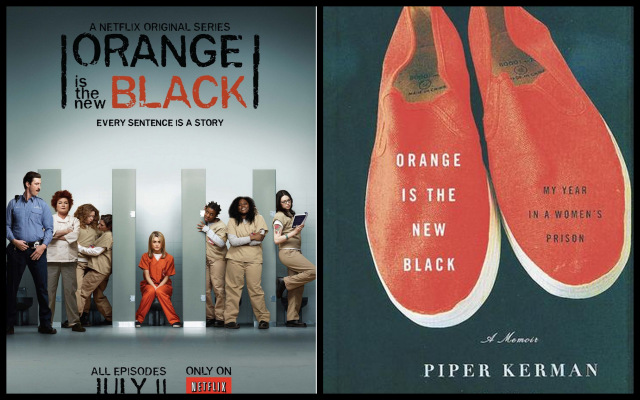
The Show’s chock-full of conflicts large and small — Chapman manages to develop a conflict with nearly every major character in addition to carrying on a very compelling romantic narrative with her ex-girlfriend. There are conflicts and romances between supporting characters, larger story arcs, the whole nine yards. The book isn’t like that. The memoir’s driving conflict, essentially, is the conflict between a privileged college-educated white girl and prison itself, and in that sense it’s definitely feels like it’s aimed towards a demographic that’s never set foot in prison and won’t find that privileged perspective off-putting. Kerman devotes ample time to simply describing prison life and relaying anecdotes about the other inmates. Kerman makes friends relatively quickly, gets along with other inmates and doesn’t reveal her lesbian past to anybody. Her life “on the outside” is stable and supportive: she’s got loving parents, her relationship with Larry is established and he’s gainfully employed, she’s got a job waiting for her on release, and her extensive circle of friends visit regularly and mail her packages, letters and books. She doesn’t see her ex-girlfriend until a month prior to release, and when she does, there’s no romantic or sexual tension between them.
Real talk: I think the lesbian storylines on the show were inspired by Kerman’s experiences at Smith, not her experiences in prison.
Larry Smith // Larry Bloom

Larry in the show is THE WORST. Larry in real life is kinda the best. Larry Smith co-founded SMITH Magazine and developed their famed “Six-Word Memoirs,” and has worked in various editor positions for Yahoo! Internet Life, Men’s Journal, ESPN The Magazine, P.O.V., Egg, Might and AlterNet. Meanwhile, Larry Bloom’s got nothing to write about until Piper goes to prison.
Larry Smith and Piper Kerman (who are now married) met in the mid-90’s in San Francisco — Kerman was Larry’s “lesbian friend” until she realized they were in love. In 1998, they’d been dating for two years when the feds-came-a-knocking, but because the court sought to extradite the drug ring’s kingpin and use Kerman in plain clothes as a witness in his trial, they put off her sentence until 2004, at which point she and Larry had been together for seven years. Because this was pre-facebook and pre-blogging-boom, Larry even made a website to get info about mailing packages and visitation to her friends and family. Honestly the amount of book-time spent discussing how amazing Larry is kinda made me want to spork my eyes out, but I digress.
Larry Smith’s Modern Love column about Piper’s incarceration was published in 2010, a few years after Kerman’s sentence.
Nora Jensen // Alex Vause
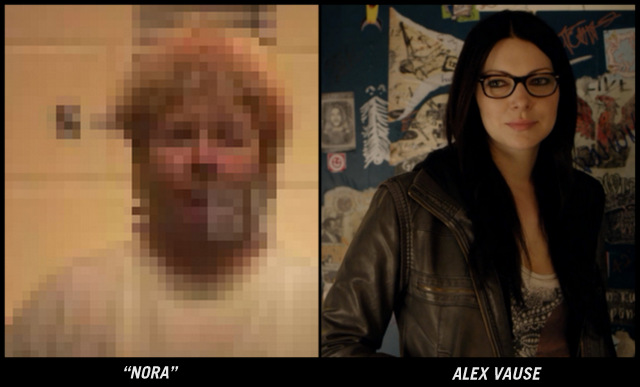
In the memoir, Kerman graduates from Smith as “a well-educated young lady from Boston with a thirst for bohemian counterculture and no clear plan.” She craves risk and adventure and eventually meets “Nora,” a member of “a clique of impossibly stylish and cool lesbians in their mid-thirties” Kerman hung out with. Nora’s an international drug trafficker Kerman describes as “a short, raspy-voiced Midwesterner who looked a bit like a white Eartha Kitt.” Before long, Kerman’s jetting to exotic locales, traveling with Nora and helping transport money. Eventually the dark side of the business, Nora’s tendency to leave Kerman alone in unfamiliar places, Nora’s desire for Kerman to transport drugs and Nora’s frequent squabbles with her partner wear Kerman down, and in 1993 she cuts all ties with Nora and moves to San Francisco.
Although it’s not discussed in the memoir and Kerman uses pseudonyms for everybody (except herself, Larry, Sister Ardeth Platte and Sister Alice Gerard), I was able to track down the actual case and the involved parties and it turns out that the drug ring’s shit hit the fan shortly after Kerman hit the road. In March 1994, according to court papers, one of the ring’s couriers was arrested at O’Hare in Chicago. He named other participants, who named other participants, and “eventually the entire conspiracy came crashing down.” The alleged drug kingpin in question is Buruji Kashamu, known to Kerman and associates as “Alhaji.” He’s the one whose anticipated extradition to the US for trial delayed Kerman’s sentence for six years — in fact, the U.S. is still trying to extradite him. Kerman was among fourteen indicted parties, along with “Nora”/Alex (real name: Catherine Wolters) and Nora’s sister “Anne” (real name: Ellen), who was actually Kashamu’s lover for a time. “I thought she was just a Wiccan heterosexual version of her sister, but apparently she was the lover of a West African drug kingpin,” Kerman writes of “Anne.”
Kerman doesn’t see Nora again until about a month before Kerman’s release date, when Nora and Kerman are shipped by Con Air to Oklahoma City, and then to the Chicago MCC, where they’ve been called, along with Anne, to testify against another member of the drug ring. In Chicago, the two girls tentatively get friendly and eventually Kerman, Nora and Anne end up in the same cell, each other’s allies in the miserable administrative facility. Kerman relays that Anne is serving a seven-year sentence in Kentucky and Nora’s doing her time in Dublin, but doesn’t reveal the length of Nora’s sentence. However, 2009 court papers state that both women are free.
The Institution
“Litchfield” 2013 // Danbury 2004

Kerman was sentenced to the “notoriously cushy” Danbury Federal Correctional Institution in Connecticut, which housed 1,300 women in its low-security facility, including 200 in the minimum-security Danbury Federal Prison Camp, where Kerman was placed. Founded in 1940, Danbury went all-female in 1993 and plans to convert back to a men’s facility this year, moving its 1,200 female inmates to a new facility in Alabama designed to boost the local economy while further isolating prisoners from friends and family. Before going all-female, Danbury was known for housing high-profile political prisoners, such as poet Robert Lowell and civil rights activist James Peck. Lauryn Hill is currently doing time at Danbury, Leona Helmsley served 18 months, and while Kerman was in custody, the entire world was super busy speculating on whether or not Martha Stewart would end up there. In fact, Danbury stopped taking new inmates while Kerman was there, declaring themselves “closed” lest Stewart get designated to Danbury. “Unclear was whether this was because the place was a broken-down dump, or for some other, more sinister reason,” Kerman writes.
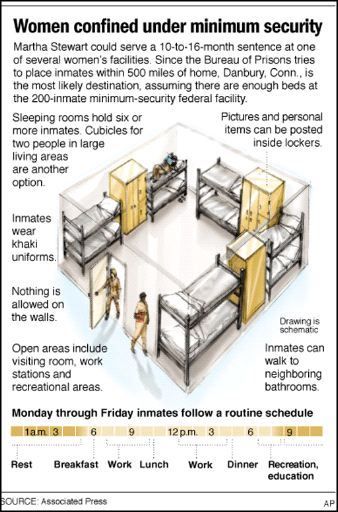
This isn’t OITNB writer/producer Jenji Kohan‘s first interaction with Danbury — Nancy Botwin of Weeds spent three years there for manslaughter. Danbury has also made appearances in The Sopranos, CSI: NY, and the film Blow. In addition to Lauryn Hill, Danbury currently houses Bernetta Willis, serving 43 years for Hurricane Katrina fraud, Cheng Chui Ping, serving 35 years for running NYC’s most lucrative human trafficking ring and Lisa Biron, an Evangelical Christian serving 40 years for producing child pornography and transporting a child for sexual purposes.
Most of the practicalities of prison life are pretty much identical in reality and the show — the often race-based social groups (or “tribes”), the work placements, the commissary, the living arrangements, visiting hours, rules, facility and equipment quality and the better treatment Piper received due to her class and race. Many of Chapman’s first day conversations with various authority figures, including Healey’s speech about lesbian sex, were pulled word-for-word from the memoir, and most show characters were clearly inspired by book characters.
But because all of the show’s plotlines and driving conflicts were fictionalized, most of what happened to Chapman didn’t happen to Kerman — Kerman wasn’t sent to SHU, nobody killed themselves, no WAC elections were held, no lesbian romances played out beneath a hole in the ceiling brought down by a patchwork cross, and there was no screwdriver-related lockdown (that particular story is likely the exaggerated compound of three other similar stories from the memoir). But that loaf Kerman got served in the SHU is real as fuck, and an inmate did get sent to the SHU for two weeks for aggressively demanding a release from her tutoring job after the supervisor had been “more abusive than usual.”
Once upon a time, Danbury and facilities like it were known as “Club Fed,” but times have changed. A report from the American Enterprise Institute (which is a neoconservative think tank, so, grain of salt) says these places were once “holiday for wealthy, well-connected criminals, who spend their days sunbathing and working on their short irons” but isn’t what it once was because “changing demographics, tighter regulations, and lengthening sentences have combined to make life in prison camps more and more similar to life in higher-security facilities.” These facilities are now packed with non-violent drug offenders of all races and lack former amenities like the liberal furlough policy, freedom to wear your own clothing, telephone calls without time limits, unlimited commissary spending and off-campus work assignments. Still, Danbury is about as good as it gets, which isn’t saying much.

The conditions in Chicago MCC, where Kerman spent her last month, were more like the harrowing documentaries and shows about prison life we’re used to seeing. (I’ve heard many people surprised by the relative freedom prisoners had on the show compared to those MSNBC documentaries about lockup.) Nobody really makes shows about solitary confinement because that would be really boring. Because you know what’s really boring? Solitary confinement.
“The women I met in Danbury helped me to confront the things I had done wrong, as well as the wrong things I had done,” Kerman writes. “The Chicago MCC was a different story… the misery of the women surrounding me rattled me, as did the pointlessness of every day that passed here, and the complete disrespect and indifference with which we were treated.”
Orange is The New Black films in Queens’ Kaufman Astoria Studios and the now-defunct Rockland Children’s Psychiatric Center on Convent Road, which was vacated in 2010 (the operations were moved to a new building on the other side of the Rockland campus) and is currently being maintained by the State and leased to Orange is The New Black. Other buildings of the Rockland State Hospital have been simply abandoned.
Work Assignments:
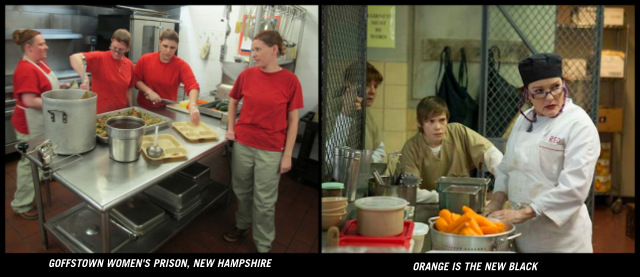
The privatized prison system benefits prison-building corporations, the companies who facilitate the expensive phone services and the manufacturers of commissary goods — but it also greatly benefits companies who “employ” prisoners to boost their bottom line. UNICOR, for example, “employs” more than 3,000 prisoners starting at 23 cents an hour manufacturing electronic equipment, most of which is for the Department of Defense. UNICOR made over $900 million in revenue last year. In Danbury, Kerman writes, the FCI inmates worked in a UNICOR warehouse making military radio components for a dollar an hour. In Danbury, inmates needed a GED to earn over 14 cents an hour, and a GED program was offered within the prison.
The facilitation and purpose of “work assignments” varies widely from institution to institution — some claim work assignments will give you valuable skills for the real world, others aim to keep the institution going on the cheap, most serve to simply keep inmates busy during the day, and many are essentially a legal form of slave labor.
The show and the memoir are consistent with their portrayal of the work program at Danbury, from the toxic mold preventing Piper from doing the education program to her eventual assignment of electrical.
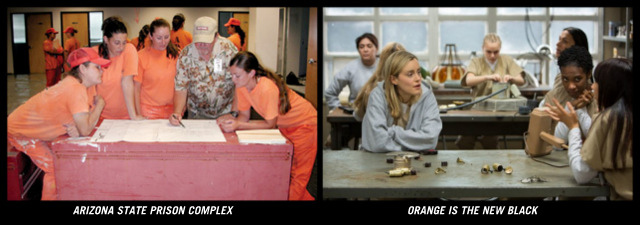
Kerman writes that prisoners worked in the kitchen, as orderlies washing floors, driving the van (Morello’s job), construction and maintenance services or in Puppies Behind Bars, which enables inmates to train seeing-eye dogs and live with their puppies 24-7. (Puppies on Parole is a similar program.) So that’s how Big Boo got Little Boo!
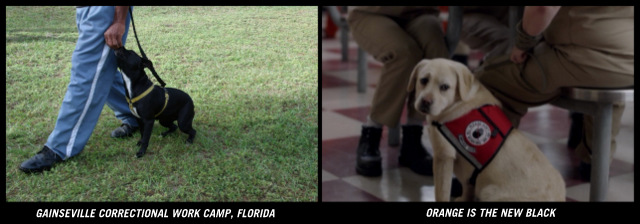
In the book, Kerman’s actually taken off-grounds to do electrical work and eventually moves into Carpentry and Construction. But as Kerman points out, the equipment was so outdated and the instructors so narrowly qualified that she doubts anybody was building really valuable work skills in Danbury.
John Rakis, in the 2005 edition of The Federal Probation Journal, writes that, “While there are many examples of prison-based vocational programs that offer market-driven training, most are designed to meet the operational needs of correctional facilities, not the long-term employment needs of prisoners.”
The Inmates
Friends, Mothers…
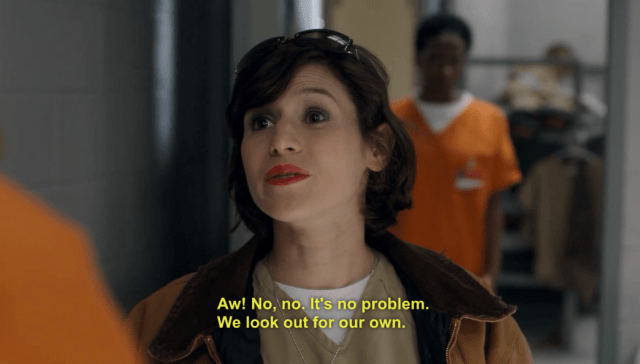
Everything I’ve read about Danbury and other minimum-security women’s prisons emphasizes the family feel that develops between inmates. Activist Doris Sage, who spent six months in the Danbury Federal Prison Camp in the late ’90s, recalls in “the edge: across borders, over the line, through prison gate” that “It was the women who helped each other; they taught us the unwritten rules and the rules each guard was likely to enforce. The women were magnificent!” Kerman and Sage both describe a lively community who planned discreet birthday parties and going away parties for each other, coordinated the Secret Santa exchange, provided pedicures and haircuts for trade, shared commissary goods, and provided emotional support. Inmates often form “families,” like Red and Aleida do on the show, headed up by a matriarch who goes by Mom, Dad, Aunt or Uncle. “More vulnerable inmates in need of protection become daughters and nieces, more masculine women; nephews and brothers,” intones the ominous narrator of a National Geographic Documentary on Female Offenders. “And the most dominant inmates assume the role of Father or Uncle.”
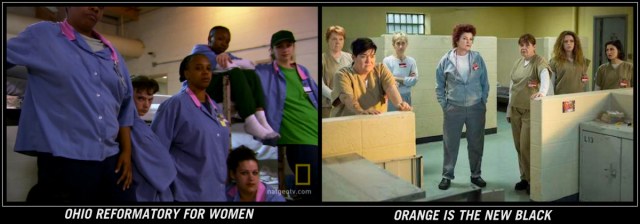
One of the primary difference between real life inmates and the show, however, is how relatively rarely children are discussed by anybody besides the Latina clique — 1 in 33 women in federal prisons are pregnant when admitted and nearly two-thirds of women in prison are mothers. Most of the show’s main ensemble was childless, even when based on book-characters with children, such as the book characters who inspired Miss Claudette and Pennsatucky.
…and Lesbians!
“True lesbians, situational homosexuals, players, prison authorities, and outside lesbian activists all play a role in the queer history of women’s prisons,” writes Jessi Lee Jackson in her paper Situational Lesbians and The Daddy Tank. On the show, everybody is gay! Or gay for the stay! There’s oral sex in the showers, hot sex in the chapel, and heaps of dyke drama.
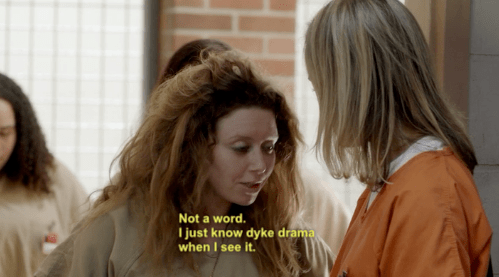
But in the memoir, Kerman writes that she was “struck by the fact that there did not seem to be any lesbian activity.” Later in the book, she remarks that “a lot of the romantic relationships I observed were more like schoolgirl crushes, and it was rare for a couple to last more than a month or two. It was easy to tell the difference between women who were lonely and who wanted comfort, attention and romance and a real, live lesbian: there were a few of them.” She does note other inmates being gay for her, like Allie who “would sometimes refer to me as her ‘wife,’ to which I would respond, ‘Fat fucking chance, Allie.’” Kerman also describes the long-term relationship between Big Boo (“a giant bulldyke… the most attractive three-hundred-pound woman I have ever seen”) and her girlfriend Trina, “a bitch on wheels.”
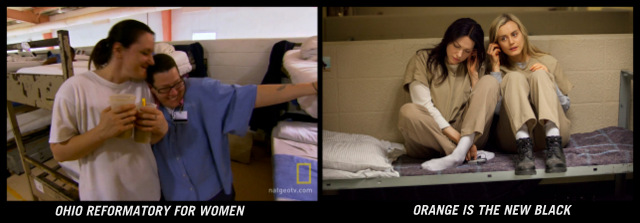
Joan Porro, a white-collar criminal who shared her experience at Danbury in the early ’00s with the neoconservative American online magazine, claimed that she “felt constantly threatened by the widespread lesbian activity that she witnessed on the prison camp ground.” Meanwhile, an angry inmate wrote to populist in 2004 in response to alarmist stories about Martha Stewart’s lesbian prospects in Danbury: “I won’t deny that there are incarcerated women who prefer the same sex. However, most of them led a lesbian lifestyle on the streets as well. This is not lesbian hell as Heidi Fleiss declares. I am not a lesbian, nor are many other women incarcerated here at FCI Danbury. I haven’t heard one person say that they want to make Martha their “girlfriend” as these magazines state.”
Research in the late ’90s showed that 30%-60% of women are in lesbian relationships in prison. A former prisoner writing for Fire Dog Lake said that KCIW PeeWee Valley, a multi-security facility in Kentucky, forbade “activities such as sitting in another inmate’s bunk or entering another inmate’s room,” but that “jails were a little more lax.”
The Characters

A lot of characters in the show were inspired by book characters and some were conglomerates of several book characters. I’m gonna get into a few of the most obvious examples here, but this isn’t all of them.
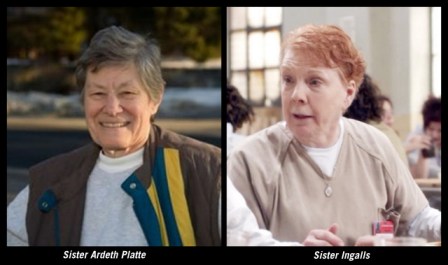
Sister Ingalls chained herself to a flagpole at a nuclear test site, but the real Sister Ingalls — pacifist nun Sister Ardeth Platte — actually cut a chain link fence around a Colorado missile silo with two other nuns and proceeded to paint the sign of the cross on the Minuteman III silo in her own blood, using a baby bottle as a paintbrush! That’s hard core.
Kerman’s “bunkie,” Miss Natalie, was the inspiration for Miss Claudette. In the memoir, Kerman and Natalie get along and become close friends, but she never finds out what Miss Natalie’s “in for.”
Yoga Jones is based on Yoga Janet from the memoir, who was doing a two-year sentence on a marijuana charge. Kerman describes her as “fiftyish, tall, fair and striking” and “like me — a middle-class drug criminal.” In the show, Yoga Jones confesses to Watson that she’s in jail on murder charges: she grew weed in her backyard, but she was an “old-fashioned drunk” who ended up accidentally killing an 8-year-old boy she mistook for a deer fucking with her crops.
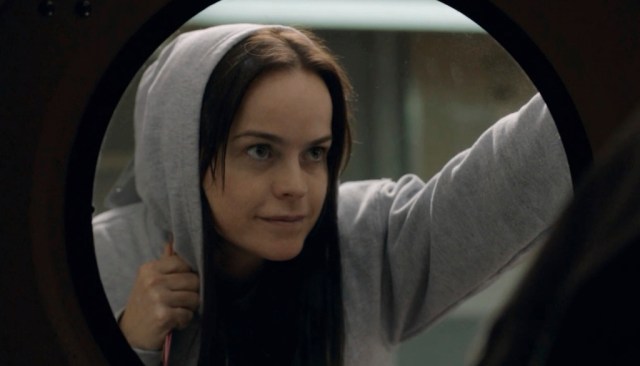
Pennsatucky, described in the memoir as “a young woman from western Pennsylvania who proudly called herself a redneck” and a crack addict, is Chapman’s enemy and Kerman’s friend. Kerman refers to Pennsatucky and her friends as “Eminemlettes,” which she defines as:
“Caucasian girls from the wrong side of the tracks with big mouths and big attitudes who weren’t taking shit from anyone (except the men in their lives). They had thinly plucked eyebrows, corn-rowed hair, hip-hop vocabularies, and baby daddies, and they thought Paris Hilton was the ne plus ultra of feminine beauty.”
Pennsatucky had lost custody of her kid, and Kerman considers her “perceptive and sensitive” while acknowledging that “[Pennsatucky] had great difficulty expressing herself in a way that was not off-putting to others, and she got loud and angry when she felt disrespected, which was often.” Like many incarcerated women, Kerman feels that nothing “would have prevented [Pennsatucky] from living a perfectly happy life, but her problems made her vulnerable to drugs and to the men who had them to offer.”
But it’d be unusual for Miss Claudette, Pennsatucky-on-the-Show or Yoga Jones to end up at Danbury, because as Kerman told The Rumpus, “in a women’s minimum-security federal prison there are few or no violent offenders. Most are low-level drug offenses, insurance fraud, bank fraud, stock fraud. I myself never witnessed a crime of violence.” In the book, we’ve got Rosemarie (probably the inspiration for Morello) incarcerated for Internet Auction Fraud (yup, ebay), a “raspy-voiced fiftyish blonde” in for stock fraud, a former investment banker who supported her gambling addiction by embezzling money and an Italian-American who was a former gang leader with the Latin Kings. That all being said, a recent news article about Danbury notes that, “although it’s considered a low-security institution, a number of women are serving long prison sentences for offenses ranging from human trafficking to murder.” But Kerman was staying in The Danbury Federal Prison Camp, which errs on the side of non-violent.
Sophia Bursett was inspired by “Vanessa Robinson,” a transgender inmate serving a short sentence who Kerman describes as “cheerful, drag-queen funny, smart and observant and sensitive to what others were thinking and feeling” as well as “six feet, four inches of blond, coffee-colored, balloon-breasted,” and who the guards call “Richard” and the inmates call the “he-she.” Like Sophia, Vanessa was denied her hormones in prison, which Kerman claimed caused Vanessa to retain “several male characteristics that would have been less evident otherwise, most notably her voice” — which is inaccurate, actually, because hormone replacement therapy for trans* women cannot change a voice which has already been subjected to testosterone. Going off hormones can impact other physical changes enabled by HRT, however, like those related to fat distribution, muscle development, body hair and skin.
Red on the show is Pop in the book — “the imposing fiftyish wife of a Russian gangster who ruled the kitchen with an iron fist” — and Kerman becomes one of Pop’s “children.”
Post-Incarceration Life
“I went back to work right away [after prison]. I was very lucky — a friend of mine created a job for me at his company. Most prisoners who come home face really significant challenges when it comes to finding work. It’s very, very hard for most people who have a criminal record to get a job. I think the system is very wasteful of taxpayers’ dollars. It’s also very wasteful of human potential. I found that most people whom I was locked up with were, you know, good people who have skills and value. Prison is a missed opportunity to nurture those things.”
– Piper Kerman, Story of Life in Prison – Marie Claire
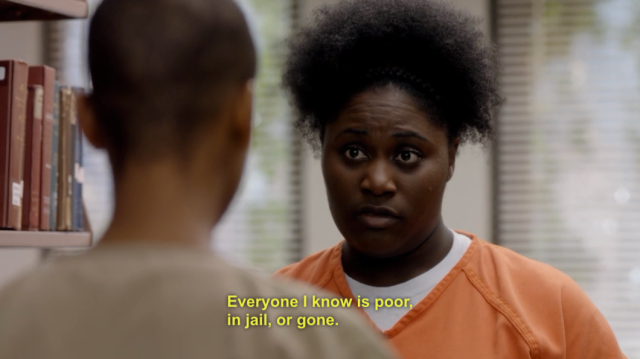
Taystee’s return inspired so many feelings: sadness that she got locked up again, happiness that she was back on the show, delight that her and Poussey could be besties again. But the conversation between Taystee and Poussey in the library was perhaps the series’ most intentional indictment of the system in the entire season, in which Taystee recalls the impossibility of “starting over” after prison. She had no place to live, clothes to wear or food to eat. It was impossible to find a good-paying job, and check-ins with parole officers loomed ever-present.
As described in depth in Michelle Alexander’s The New Jim Crow, former prisoners with drug offenses on their record face insurmountable challenges. They may find themselves ineligible for food stamps, public housing (or any housing), federally funded health and welfare benefits and federal educational assistance — demerits which hit especially hard for mothers with children and for women of color, who already suffer discrimination in those sectors with or without a record. “Once labeled a felon, the badge of inferiority remains with you for the rest of your life, relegating you to a permanent second-class status,” Alexander writes. “Today a criminal freed from prison has scarcely more rights, and arguably less respect, than a freed slave or a black person living ‘free’ in Mississippi at the height of Jim Crow.” Many will lose the right to vote or to hold a driver’s license.
Taystee, who owes the prison “$900 in fees,” is not alone with that type of debt — upon release, former inmates often are required to pay fees for parole or probation, jail book-in fees, jail per diems for pretrial detention, pre-sentence report fees and so many more. Missing a payment could land you back in jail.
Securing post-incarceration employment is really really really really hard. Employers are biased against applicants with criminal records, and prison time leaves gaps in employment history, training and education. Jobs requiring minimal training, like factory work, are sparse in this economy, leaving only the service sector. Those who fail to get a job or return to the underground economy in desperation will usually end up back in prison.
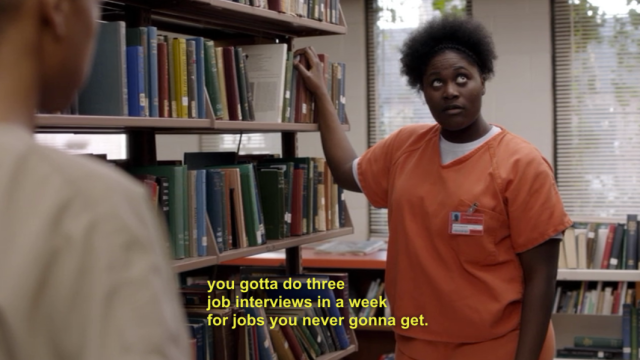
While in Danbury, Kerman attends the Danbury FCI Job Fair, an annual event “that paid lip service to the fact that its prisoners would rejoin the world.” She judges the event as only slightly helpful, and recalls panelists being asked by inmates where to get training or find job listings or jobs that hired women with records, to which the panelists suggested using the Internet. The inmates inform the panelists that there’s no internet, computer lab or computer training. Despite the practical futility of it all, Kerman points out: “What was striking… was that the [volunteers and speakers] spoke to us prisoners with great respect, as if our lives ahead had hope and meaning and possibility. After all these months at Danbury, this was a shocking novelty.”
She also attends reentry classes. The health class, taught by a Correctional Officer who worked food services at the FCI, didn’t disclose how to obtain affordable health care, let alone reproductive, behavioral, psychiatric or substance abuse treatment. A class called “Positive Attitudes” was led by the warden’s secretary, who talked about how she had fun at a party despite not being able to diet into her “party dress.” The “housing” class, taught by another vocational instructor, focused on home repair and aluminum siding, offering no solutions when inmates asked about how to find an actual apartment to rent. Kerman writes:
I looked around the room in disbelief. There were women in there who had lost their parental rights and who would have to battle to reunite with their children; women who had nowhere to go and so would be heading to homeless shelters; women who had never worked in the mainstream economy and must find real jobs or end up back in prison. I had none of these concerns, because I was so much luckier than the majority of women I’d been living with in Danbury, but I felt disrespected by how trivial these classes were turning out to be.
Many groups are working to change these conditions, however, such as The Women’s Prison Association Re-entry Services. There are regional initiatives too, like Jersey’s Female Offender Re-Entry Group Effort, and Mercy Programs Northeast’s LIFE Prison Reentry Program for Women Prisoners, which provides business education programs to Oregon female convicts focused on teaching skills required to establish self-sufficiency and economic stability through business, entrepreneurship and pro-social life skills.
The Second Chance Act of 2008 authorized federal grants to government agencies and nonprofit organizations designed to reduce recidivism. Facing overcrowding and budget cuts, California, Michigan, New York and other states have begun expanding job programs for prisoners.
The Patient Protection and Affordable Care Act should grant both prisoners and former prisoners comprehensive and continuous health care starting in January 2014. Clinics like The Transitions Clinic in the Bay Area and Unity Clinic in DC offer health care to parolees and ex-prisoners, and A New Way of Life Re-Entry Project provides housing and re-entry support for women and children in South Central Los Angeles.
Ultimately, Orange is The New Black isn’t a documentary about imprisoned women and the experience of women in the deeply flawed and continually worsening American prison system. It’s a television show, intended more to engage and entertain than educate or agitate. And Kerman’s book isn’t the memoir of a woman whose life stands as testament to how fundamentally broken the system is — if anything, it’s a book that uses the relative ease with which Kerman navigated the system to highlight the difficulties that other women, most notably poor women and women of color, face. Ultimately, the message is that Kerman (and Chapman) are able to get out okay, to have “normal” lives — and that this affords them the opportunity to pass on knowledge about those who haven’t because they can’t. The vast majority of women in the prison system are not going to be able to continue with their lives largely unaltered by the Department of Corrections, and truthfully, neither the book nor the show probably go far enough in terms of depicting the Sisyphean situation incarcerated women are forced into. But it does seem that both are making a good faith effort to push that conversation forward, and given how desperately this conversation needs to be had on a national level, it seems smart to take the show up on its offer and use this as a jumping off point to start talking about the real women whose stories are implied on the screen.
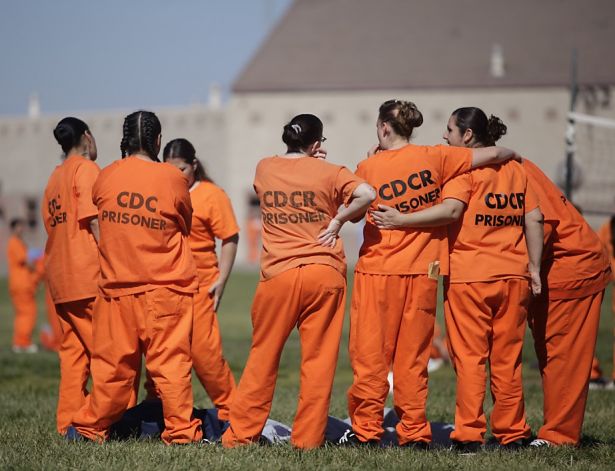
Resources For Further Action:
The Drug Policy Alliance: The Drug Policy Alliance envisions a just society in which the use and regulation of drugs are grounded in science, compassion, health and human rights, in which people are no longer punished for what they put into their own bodies but only for crimes committed against others, and in which the fears, prejudices and punitive prohibitions of today are no more.
Incite! Women of Color Against Violence: INCITE! Women of Color Against Violence is a national activist organization of radical feminists of color advancing a movement to end violence against women of color and our communities through direct action, critical dialogue and grassroots organizing.
Women’s Prison Association: WPA is a service and advocacy organization committed to helping women with criminal justice histories realize new possibilities for themselves and their families. Our program services make it possible for women to obtain work, housing, and health care; to rebuild their families; and to participate fully in civic life. Through the Institute on Women & Criminal Justice, WPA pursues a rigorous policy, advocacy, and research agenda to bring new perspectives to public debates on women and criminal justice.
Women & Prison: A Site For Resistance: Women and Prison: A Site for Resistance makes visible women’s experiences in the criminal justice system. Documenting these stories is integral to this project of resistance. The stories are supported by a collection of resources, such as organizations, reports, essays, and links to a wide range of information on women and prison. The contents of this website are fluid and constantly changing. We expect to add stories, articles and resources on a regular basis. Your feedback and contributions are welcome.
Just Detention: Just Detention International is a health and human rights organization that seeks to end sexual abuse in all forms of detention. The rape of detainees, whether committed by corrections staff or by inmates, is a crime and is recognized under international law as a form of torture. In the U.S., sexual assault in detention has reached epidemic levels, with more than 200,000 people subjected to this form of violence every year.
Nation Inside: Nation Inside is a platform that connects and supports people who are building a movement to systematically challenge mass incarceration in the United States.
Families Against Mandatory Minimums: FAMM advocates for state and federal sentencing reform, and mobilizes thousands of individuals and families whose lives are adversely affected by unjust sentences to work constructively for change.
Also, Piper Kerman has a list of Justice Reform Organizations on her website.







